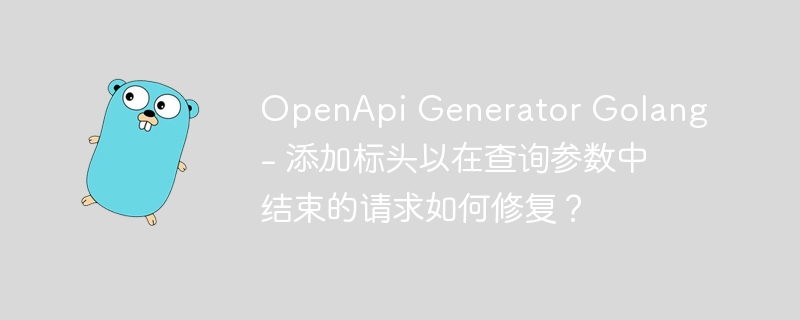 Backend Development
Backend Development
 Golang
Golang
 OpenApi Generator Golang - Adding header to request ending in query parameters how to fix?
OpenApi Generator Golang - Adding header to request ending in query parameters how to fix?
OpenApi Generator Golang - Adding header to request ending in query parameters how to fix?

php Editor Banana encountered a problem when using OpenApi Generator Golang: when ending the request in query parameters, how to add headers to fix this problem. In this article, we will explore the solution to this problem and provide some practical tips and steps to help readers solve similar problems. Whether you are a beginner or an experienced developer, this article will provide you with valuable information and guidance. Let’s take a look at how to fix this problem!
Question content
I'm trying to generate a go client, but the generator doesn't recognize the header and won't let me pass it to the server as a header - instead, it's as a query parameter send.
info:
title: api
version: "1.2"
servers:
- url: https://example.com
paths:
/ping:
get:
summary: checks if the server is alive
parameters:
- in: header
name: x-request-id
schema:
type: string
format: uuid
required: true
responses:
'200':
description: request has been successful
content:
application/json:
schema:
type: object
properties:
returned_url:
type: stringThis is the generator I'm using:
# https://github.com/openapitools/openapi-generator/blob/master/docs/generators/go.md
docker run --rm -v "${pwd}:/local" openapitools/openapi-generator-cli generate \
-i /local/spec.yaml \
-g go \
-o /local/internal/infrastructure/sdk \
-p enumclassprefix=true \
-p generateinterfaces=true \
-p isgosubmodule=true \
-p packagename=sdkYou'll notice that it generates this line, which adds the header value I passed to the query parameter:
parameterAddToQuery(localVarQueryParams, "X-Request-ID", r.xRequestID, "")
Is this a bug? What can I do about this?
Workaround
This looks like a bug in go templates: https://www.php.cn/link/88d25099b103efd638163ecb40a55589
It should be similar to how it is done in Java templates: https://www.php.cn/link/227bd2473d68947040e511b7f29ce553
The above is the detailed content of OpenApi Generator Golang - Adding header to request ending in query parameters how to fix?. For more information, please follow other related articles on the PHP Chinese website!

Hot AI Tools

Undresser.AI Undress
AI-powered app for creating realistic nude photos

AI Clothes Remover
Online AI tool for removing clothes from photos.

Undress AI Tool
Undress images for free

Clothoff.io
AI clothes remover

AI Hentai Generator
Generate AI Hentai for free.

Hot Article

Hot Tools

Notepad++7.3.1
Easy-to-use and free code editor

SublimeText3 Chinese version
Chinese version, very easy to use

Zend Studio 13.0.1
Powerful PHP integrated development environment

Dreamweaver CS6
Visual web development tools

SublimeText3 Mac version
God-level code editing software (SublimeText3)

Hot Topics
 Go language pack import: What is the difference between underscore and without underscore?
Mar 03, 2025 pm 05:17 PM
Go language pack import: What is the difference between underscore and without underscore?
Mar 03, 2025 pm 05:17 PM
This article explains Go's package import mechanisms: named imports (e.g., import "fmt") and blank imports (e.g., import _ "fmt"). Named imports make package contents accessible, while blank imports only execute t
 How to implement short-term information transfer between pages in the Beego framework?
Mar 03, 2025 pm 05:22 PM
How to implement short-term information transfer between pages in the Beego framework?
Mar 03, 2025 pm 05:22 PM
This article explains Beego's NewFlash() function for inter-page data transfer in web applications. It focuses on using NewFlash() to display temporary messages (success, error, warning) between controllers, leveraging the session mechanism. Limita
 How to convert MySQL query result List into a custom structure slice in Go language?
Mar 03, 2025 pm 05:18 PM
How to convert MySQL query result List into a custom structure slice in Go language?
Mar 03, 2025 pm 05:18 PM
This article details efficient conversion of MySQL query results into Go struct slices. It emphasizes using database/sql's Scan method for optimal performance, avoiding manual parsing. Best practices for struct field mapping using db tags and robus
 How do I write mock objects and stubs for testing in Go?
Mar 10, 2025 pm 05:38 PM
How do I write mock objects and stubs for testing in Go?
Mar 10, 2025 pm 05:38 PM
This article demonstrates creating mocks and stubs in Go for unit testing. It emphasizes using interfaces, provides examples of mock implementations, and discusses best practices like keeping mocks focused and using assertion libraries. The articl
 How can I define custom type constraints for generics in Go?
Mar 10, 2025 pm 03:20 PM
How can I define custom type constraints for generics in Go?
Mar 10, 2025 pm 03:20 PM
This article explores Go's custom type constraints for generics. It details how interfaces define minimum type requirements for generic functions, improving type safety and code reusability. The article also discusses limitations and best practices
 How to write files in Go language conveniently?
Mar 03, 2025 pm 05:15 PM
How to write files in Go language conveniently?
Mar 03, 2025 pm 05:15 PM
This article details efficient file writing in Go, comparing os.WriteFile (suitable for small files) with os.OpenFile and buffered writes (optimal for large files). It emphasizes robust error handling, using defer, and checking for specific errors.
 How do you write unit tests in Go?
Mar 21, 2025 pm 06:34 PM
How do you write unit tests in Go?
Mar 21, 2025 pm 06:34 PM
The article discusses writing unit tests in Go, covering best practices, mocking techniques, and tools for efficient test management.
 How can I use tracing tools to understand the execution flow of my Go applications?
Mar 10, 2025 pm 05:36 PM
How can I use tracing tools to understand the execution flow of my Go applications?
Mar 10, 2025 pm 05:36 PM
This article explores using tracing tools to analyze Go application execution flow. It discusses manual and automatic instrumentation techniques, comparing tools like Jaeger, Zipkin, and OpenTelemetry, and highlighting effective data visualization





